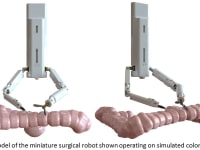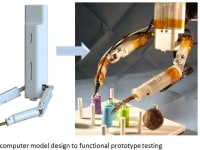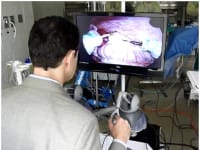
PROBLEM
Surgery is intrinsically invasive and unnatural. One of more prevalent surgeries that could be improved is colon resection, with more than 380,000 annually in the U.S. Commonly, a six inch incision provides access to the colon for the surgeon to visualize and manipulate the target area. This is beneficial for the surgeon, as it provides immediate sensory feedback. Unfortunately for the patient, this technique leads to an extended, painful recovery, large scars, and other potential complications.
Some resections are able to be done through minimally invasive laparoscopic techniques, in which long slender tools are inserted through multiple small incisions. The number of procedures (<15%) that use laparoscopic techniques is largely limited due to the difficulty. A better tool would allow more widespread use of laparoscopic techniques, resulting in immediate patient benefits such as reduced hospital stays, reduced cost, and improved cosmetics. Our robotic surgical device aims to eliminate difficulties associated with laparoscopic techniques while increasing patient benefits.
SOLUTION
The miniature robot is inserted through a single incision at the navel, which makes it less invasive than most current laparoscopic procedures. These robots represent a paradigm shift in robotic surgery by allowing the robot’s actuators to be entirely contained within the abdominal cavity during the surgery. Due to the software intermediary between the surgeon and the robot, the surgeon need not be in the operating room. The surgeon operates from a user interface and controls the robot while viewing the procedure on a monitor. The controller has the ability to scale the surgeon movements, reduce hand tremors, and potentially perform autonomous, repetitive tasks such as suturing. Early testing of this type of robot has shown that they are a practical device that is evolving into a useful surgical tool.
OPPORTUNITY
The only FDA approved surgical robot is the da Vinci Surgical Robotic System (Intuitive Surgical $22B/yr). Since the da Vinci is the only available robotic option, it has control of the market, but has priced itself out of a large portion of it. A growing number of patients are accepting the benefits of robotic surgery, and as this acceptance gains traction, a new market for less expensive procedures will emerge. The proposed alternative represents a decrease in cost passed along to the patient, reducing the per procedure cost from 25k for a current procedure, to 6k for a miniature robot. These robots are designed such that large portions can be sterilized for repeated usage. This characteristic along with the ability to be injection molded makes the miniature robots a cost effective option.
This type of platform also has room for growth as a tool for other surgical procedures as well as applications in situations such as those for first responders (EMT, fire, and police), soldiers, and astronauts when a trained surgeon may not be immediately accessible. The portability and relative disposability of a system such as this opens up an entirely new set of applications that have seen restricted use of surgical robots due to their size.
Video
-
Awards
-
 2012 Top 100 Entries
2012 Top 100 Entries
Like this entry?
-
About the Entrant
- Name:Jack Mondry
- Type of entry:teamTeam members:Tom Frederick
- Software used for this entry:Solidworks, MATLAB, Maple
- Patent status:patented








